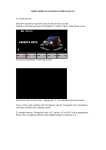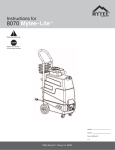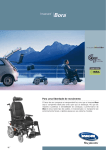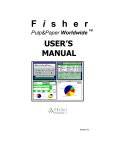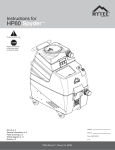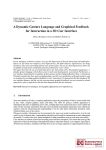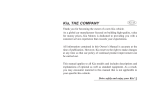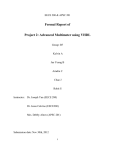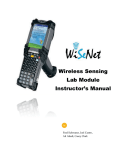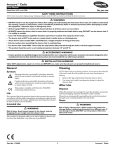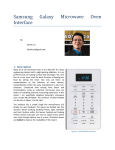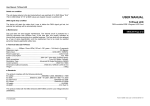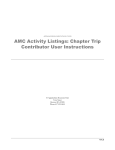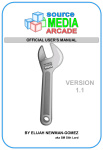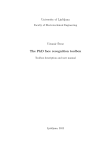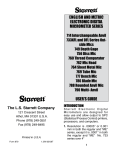Download Minor Designers Pass 1 Portfolio - Courses
Transcript
EECE 418 (Winter 2014) Minor Designers Pass 1 Portfolio Jag Dhami Flynn Howling Wei Yu (Tim) Nan Russell Porter Student #: 25820093 Student #: 22749097 Student #: 70192091 Student #: 72383094 EECE 418 (Winter 2014) Tasks and Requirements Introduction Current System Our proposed interactive system is a tool to book a taxi cab using a smartphone in any location with internet access. The system will also provide the current status of the cab(s). The goal will be to preserve the benefits of the existing system and methods of booking while fixing any gaps in missing functionality and confusion. The current system of booking a cab is a process that has existed in one form or another for decades and has been ingrained in cultures around the world. Currently, a user looking for a cab can go out and try to hail a taxi by grabbing the attention of taxis that pass by. This method is relatively simple to follow and tends to be quick in crowded, urban areas where taxis are plentiful. The method is also very private, with no information of the user being given to the taxi driver, just a location. This method allows for on demand access, without any prior booking or planning and is very useful for sudden, unexpected need of transportation. However, this method can fall flat during off-peak hours or in less crowded areas, where cabs are not frequenting the roads. Hailing a cab can take an unacceptably long time. In low visibility settings, such as night-time or rain/fog the taxi drivers have limited vision and users may have to put themselves in a harmful situation to catch the attention of a taxi. It is also hard for users to determine if a taxi is occupied or not and while there is often a “TAXI” sign on top which is illuminated based on availability, this is not common knowledge and does not help users who do not understand the affordance. The alternative is the user can directly call the cab company and book a taxi, which will come to a location specified by the user and a specified time, if for the future. This method provides convenience as users can book a taxi and then do other activities while waiting for the cab to arrive. In uncomfortable weather, users do not have to be outside trying to find a cab. This method can also allow for future booking, if the user anticipates need for transportation, which means they do not need to worry about finding a taxi when the time comes. Like before, this method also comes with its own set of issues. Once a user books a taxi via phone call, they have no way to get the status of the cab easily. Calling the cab company back often does not result in accurate, meaningful results. This can lead to confusion and sometimes double booking. If a user books a taxi for a future time, there is the possibility they have forget they have the booking, leading to them calling a taxi again. With the new system (a smartphone application), the main goal is the ability to allow users to see current status and any alerts. It will eliminate confusion with arrival times, future bookings, nearby taxis while retaining as many as benefits of the current methods as possible. EECE 418 (Winter 2014) Process Changes The biggest process change between the current system and the new system will be the inclusion of automatic information fill out. Users can have their personal information, such as name, phone number and current location retrieved from the phone. New Functionality Users will now have access to the status of their requests, both current taxi ETA and viewing future bookings. Also, users can have a map with nearby taxis marked on the map. Expected Users We expect the types of users to be focused around travellers, both within the city and visitors. We anticipate that tourists will be major users. We expect tourists to have a basic understanding of how to book taxis but little to no experience with the city they are in. The types of locations for users would be places like the airport, tourist attractions, restaurants, hotels, car rental locations and relatives’ homes. For these users, we expect most bookings to be for the current time with very little future bookings. Another expected user is the night life member. These users are often out late into the night and need transportation home, either because there are no late night buses or to avoid potential DUIs from driving themselves home. These users are very comfortable hailing or booking taxis and will likely be familiar with how some of the existing mobile booking applications work. The types of locations for these users include bars, pubs, night clubs and homes. We don’t anticipate these users will book in advance very often, if at all. Another expected user would be disabled persons. These users need travel accommodations which have access to any devices they require, such as lifts for wheelchair users. These users are likely to have another person with them, increasing likelihood that someone knows the taxi booking process well as well as the locations they need taxis for. Expected locations include personal home, medical facilities, family homes and various quality of life facilities. Another expected user is the local resident who has daily transportation covered. These users may need a taxi for emergency situations, heading out to locations with luggage or other items or if they find themselves out late at night when public transportation is not available. Expected locations include the airport, bars/clubs, hospitals, doctors/dentist’s office and homes of acquaintances. These users will likely use current and future bookings about evenly, depending on the location. EECE 418 (Winter 2014) Expected Use and General Functionality We expect users will use the system in order to book taxis to a location they specify. Users will either book a taxi to come immediately or for a future date/time. We also expect users to use the system in order to determine the ETA of an incoming taxi and its current location, to review their future bookings and to see taxis near their current location. Users should be able to modify their bookings, which may include cancelling a taxi that is on its way or a future booking. Users should be able to select the type of vehicle they need, such as a standard 4 door sedan or a van with a lift. Constraints Our system will have to be outfitted to support modern smartphones and their OS. To cover the widest audience, the system must work on iOS and a wide band of Android versions (not only the latest). The system will have to be able to communicate with any systems already in place by taxi companies in order to retrieve data about their taxi fleet. We must also consider the screen real estate on smartphones is relatively small, so text needs to be of a certain size for readability. For iOS design, the design will have to conform to expected standards set by Apple in order to make it through App Store screening. Concrete task examples Tom Suzuki is a Japanese tourist staying at the Fairmount hotel downtown and wants to visit Stanley park for the day. He has no idea how to get around the city and thus decides to try out our application in order to book a taxi. When he opens the app he enters in his name and phone number in case the taxi company needs to get in contact with him. Because he does not know the city well he relies on the app to determine his current location and sets it as the location for pickup. Since he wants the taxi right away he also will not change the time of the booking and does not care for the type of vehicle hes gets in so he simply clicks to book a taxi with the default information. Tom simply waits until the taxi gets to his location at the specified time. Discussion: In this case the user is someone who has minimal knowledge of his current location and requires the app to successfully determine their location and display so in the booking. This task is routine thus it needs to be simple that first time users know exactly how to use it on their first try. Frequent flyer (booking in advance, uses the app regularly) Felicia Smith is a frequent flier constantly going to and from airports for work. She has already signed up for the application and uses it regularly. She is leaving Vancouver in one week for a trip to Toronto and wants to set up her transportation now so its ready for her arrival. She uses the app to book two taxis. The first is for 7am from her apartment in Vancouver, and the second EECE 418 (Winter 2014) is for 2pm at the Toronto airport. She is able to see that she has the two bookings and can view the details before heading out next week. She gets an alert when her taxi is nearly at her place for the 7am pick up and she goes down to meet the driver. She pays the driver when getting to her destination, the YVR airport, and flies to Toronto. She gets another notification when she is at the airport and her taxi is ready, which she meets outside and heads out to her hotel in. She can then see on the app that she has no more pending bookings. Discussion: In this case the user is a frequent user of the app. She will want to be able to book taxis well in advance and check that the bookings are ready for her. The solution should allow someone to quickly book multiple taxis once signed in and be able to track all their bookings. Party goer (edit a booking) Peter Parker is a young 22 year old who likes to go out drinking with his group of friends thus he is a frequent user of the app as he often books cabs to take him home from a night out. On this particular night he is going out to celebrate his best friend’s birthday. They had planned to go to a club on the Granville strip and because Peter has to work early in the morning he made sure to book a cab with the app in advance for 1AM so that he will not have to look for one later. However once at the club his group of friends are not having any fun and decides that they want to try to go somewhere else instead. They leave to go to a bar in Gastown and Peter realizes that he must change the booking that he had already made. He starts the application on his phone and chooses the booking that he had made previously. He then edits the location for pickup to be in Gastown rather than Granville and then submits the request. Discussion: In this case the user is someone who has used the app before. The user is aware of how to book taxis with the app as well as where to access the booking. The system should allow the bookings that were made to be changed easily. Business man (review bookings) Bob Bradley is a businessman who often meets with clients as part of his role in the company he works for. On one particular day he met with several clients for lunch who are from out of town and do not have means of transportation. One they are done eating the clients ask Bob if he could arrange for transportation for them in order to get to their next destinations. Having been an user of the app before he simple accesses the app’s booking screen and starts to book the taxis. He chooses the location to be his current location and books the cab for now with no preference for the vehicle. He then immediately starts another booking using the same preferences from before. He continues doing so until all the clients have taxis that they can get into. Then he is notified one by one as the taxis arrive. Discussion: In this case the user is someone who has used the app before. The user is aware of how to book taxis with the app as well as the fact that multiple bookings are allowed at the same time. The system should allow the bookings to be processed quickly and also alert the user as each taxi arrives. EECE 418 (Winter 2014) Disabled( book a taxi with wheelchair access) Dylan Docker uses a wheelchair and needs an easy way to get around the city when he can’t get a ride. He wants to go somewhere not easily accessible by bus and get to his destination without much hassle. Dylan uses the app to book a taxi, and when selecting a vehicle immediately sees the option for a wheelchair accessible van. He selects that option and can see the estimated time of arrival for his taxi. Discussion: This case mostly shows how special accommodations should not make the booking process more difficult to the user. People with disabilities make up a large and important part of the market that we need to consider. Casual user (cancel booking) Cindy Carp rarely uses taxis opting to bike or bus when she can. Cindy needs to go to the airport with her luggage and decides to book a taxi a few days in advance. She signs in the the application and reserves a taxi from her house a few hours before her flight. After packing she realizes she can easily carry her luggage and decides she can take the Skytrain instead of paying for a taxi. She opens the application up again and can quickly see her taxi reservation. She opens it and cancels the reservation. She can immediately see that she no longer has a taxi reserved and can now take the train to the airport. Discussion: This case takes into account the likely situation that a user will want to cancel a taxi that they booked in advance. It should be obvious to the user that they have bookings, and that they can cancel those bookings at any time. Tasks Summary ● ● ● ● ● ● ● ● Book a taxi for a future date with a given time and location for pickup Booking multiple taxis Get a taxi for immediate use from their current location Booking a taxi with a specific vehicle type in mind Check the location or ETA of a booked taxi coming for pickup Review taxis they have booked for future trips Cancel a booking they no longer require Edit a taxi booking to a different time or location Tentative list of requirements EECE 418 (Winter 2014) ● ● ● ● ● ● ● ● ● ● ● ● Must be able to book a taxi in advance Must be able to request a taxi for immediate use Must be able to view bookings in the app Must be able to cancel a booking Must be able to edit a booking Must be able to book multiple taxis Must be able to view where a taxi coming to pick you is located when it is on route to you Must show the estimated time of arrival when a taxi is on route to you Must be able to view your location on a map when selecting a location for pickup Must be able to select from multiple vehicle types Must be able to select the time you wish to reserve a taxi for Must be able to notify users when taxis arrive Sketches of Design Alternatives EECE 418 (Winter 2014) Design 1 Design 2 EECE 418 (Winter 2014) Design 3 EECE 418 (Winter 2014) EECE 418 (Winter 2014) Low-fi Prototype Analysis & Evaluation Prototype Please view the prototype online for the best experience: bit.ly/418proto You can use a PC to view the prototype or an iOS device. If you use an iOS device, it is best if you use “Add to Home Screen” in Safari to add the prototype to your iOS home screen. Then the prototype can run full screen when launched directly from the home screen instead of through Safari. See Appendix 1 for screenshots of the prototype screens. Notes about the online prototype The initial screen which asks the user to provide a name and phone number only appears on the first use of the app. The phone number field will use a phone number keyboard to prevent invalid input. The map view on the booking screen will be draggable in a real implementation to allow the user to choose a different pick up location. There are currently three layouts for the home screen. Home screen when there are no bookings, when is an incoming taxi, and when there are future bookings. You can view all these layout variations by picking the relevant screen from the “Screens” menu in the prototype viewer. Analysis Cognitive Walkthrough See Appendix 3 for full walkthrough results. Generally, the app is successful in accomplishing the tasks because it is so simple, there are very few paths for the user to take compared to many other more complex apps. The key issues identified are listed in the table below. Summary of issues identified Screen Task Issue Severity (1-3) Sign up (first Any with a new Correct action (entering name/phone #) could 2 EECE 418 (Winter 2014) use only) user be made more clear by making the continue button disabled until there is valid input in both fields Booking Any involving booking with a different location than current Correct action (setting custom pickup location) 3 is not clear unless the user experiments by swiping the map. A NUX (New user experience) may be necessary so the user learns this action. Booking > Set Pick up Time Returning to the booking screen The user may try to press the disabled top left cancel button which is slightly grayed out because it is on the screen underneath the time picker screen. Best if the screen underneath is blurred or some other effect to make it completely obvious. Upcoming bookings list (home) Canceling a booking, tapping Edit button If the user is not familiar with iOS, they may not 1 know the convention of tapping edit to show deletion buttons on the table view items. Upcoming bookings list Editing a booking The user may be confused. If they are intent on 3 “editing” their booking, which is not possible in our prototype, they will be confused. They need to cancel and rebook their taxi. 2 Heuristic Evaluation See Appendix 2 for full heuristic evaluation. Informal Evaluation Evaluated with two potential users using the observational method. Gave them an objective and watched them navigating through the app giving no input, except where the prototype is lacking feedback (for example: if they try to drag the map on the booking screen, inform them that the map would drag in the real implementation). Participants #1: Baby boomer parent, has a smartphone but doesn’t use it to its full extent #2: University undergrad, who didn’t sleep last night, familiar with smartphones Task Notes (#s are correlated to the participant above) Book a taxi to pick yourself up here right now. #1: Didn’t type in name, pressed continue immediately. #2: Good EECE 418 (Winter 2014) Find how long you will have to wait for the taxi #1: Good. Confused by “Book another taxi” button though, it seems duplicitous anyways. #2: Straightforward Cancel the taxi #1: Seems confused about the use of the cancel. Need popup to confirm cancellation. #2: Straightforward Book a taxi to take you to #1: Didn’t try dragging the map to change location. Change the airport at 6pm tonight “location” field to “pick-up location” with in a van #2: Straightforward Book a taxi to pick you up #1: Seemed to understand the process at this point. at Granville and Seymour #2: Dragging the map seemed obvious. Expects to be able to edit tomorrow morning. the location by typing an address as well. Change the booking to pick you up an hour later tomorrow. #1: Should add a way to change taxis. #2: Should add a way to change taxis. Summary of Discussions The analysis and evaluations of the prototype helped us discover many problems with our first prototype. In addition, team meetings discussing the prototype helped us identify some major oversights. Our heuristic evaluators noticed that we don’t have a way to notify the user when the taxi arrives in our low-fidelity prototype. We are planning to add a push notification and in app popup when the taxi arrives for the next prototype. In team meetings, we realized that when the app is opened and there are no existing bookings, we can immediately display the booking screen, rather than show the bookings map screen, saving the user one tap. From the informal observational evaluation, we identified that the “Book another taxi” button is duplicitous with the “Book” button on the bookings list screen, and the user most of the time does not want to book more than one taxi, so having a large button for this purpose is unnecessary. Additionally, we identified that we need to add an address input screen, rather than rely on the user to set the pick up location by using a map. We need a new user experience to train users to drag the map to set their pickup location. Finally, we need an easier way to change a taxi booking. These are the largest changes we will make as a result of our discussions and analysis, there are more subtle changes mentioned in the various analysis results. Management of Resources Jag Dhami EECE 418 (Winter 2014) Tasks completed in Pass 1: ● Initial paper prototype mock ups ● Project Definition ○ Scope ○ Current System ○ Issues ○ Changes to current system ○ Expected Users ● Constraints ● Iterative improvements to selected prototype These tasks took roughly 7 hours to complete. Using a rate of $40/hour for less experienced designers, the cost of this effort would be $280 for this pass. For pass 2, we anticipate they will spend time working on the same tasks from pass 1 and also working on a high fidelity prototype. Also, time will have to be allocated to fully realize changes to be implemented based on the heuristic evaluation from pass 1. The anticipated time spent for pass 2 will be the range of 10-15 hours, putting the cost of this effort at $400 - $600, using the same hourly rate as pass 1. Flynn Howling Tasks completed in Pass 1: ● Initial paper prototype mockup ● Concrete Task Examples ● Tentative List of Requirements ● Iterative improvements to low fidelity prototype ● Heuristic evaluation The estimated time spent to complete these tasks was 5 hours. At a rate of 40 dollars an hour the cost of this effort would be about $200 up to this point. For pass 2, he is anticipated to work more on analysing the data received from the heuristic evaluation and cognitive walkthroughs. Using this information to make changes to the low fidelity prototype, and work on creating a high fidelity prototype to demo. The estimated time to be spent on this is 10-15 hours giving a cost of $400 - $600 dollars at $40 an hour. Wei Yu (Tim) Nan Tasks completed in Pass 1: ● Initial paper prototype mockup ● Concrete Task Examples ● Tentative List of Requirements ● Iterative improvements to low fidelity prototype The estimated time spent in order to complete these tasks was about 5 hours. At a rate of $40 EECE 418 (Winter 2014) dollars an hour the cost of the effort spent on the pass 1 prototype would be around $200. For pass 2 he will help create more prototype illustrations. He will also help create a high fidelity prototype based off the low fidelity prototype, feedback from the heuristic evaluation and cognitive walkthroughs. The estimated time expected to complete these tasks for pass 2 will be around 10-15 hours, which comes at a cost of $400 - $600 dollars at the same rate as pass 1. Russell Porter Tasks completed in Pass 1: ● Setting up Proto.io project ● Design of booking screen ● Iterative improvements to other screens ● Walkthrough ● Informal observational evaluations The estimated time spent to complete these tasks was 7 hours. At a rate of $40/hour the cost of the design and analysis is $280. For pass 2, he will continue working on the design of the booking interface and evaluations. We estimate he will spend approximately 10-15 hours, and the cost of design and analysis will be $400 - $600. EECE 418 (Winter 2014) Appendices Appendix 1 - Low-fi Prototype screens EECE 418 (Winter 2014) Appendix 2 - Heuristic Evaluation See next page. Heuristic)Evaluation)for)Team)1,)Minor)Designers) ! Design of a web-based tool to allow people to book a taxicab from wherever they are, and to know the status of the cab fleet! ! ! ! ! ! ! ! ! Team:&Hard*2*Use& ! Luis&Lu&Gan& 19210087& & & Cary&Wong& 19096072& Evaluator& & ! & Frank&Ke&Xu& 63266084& Evaluator& & & Leon&Lixing&Yu& 75683094& Evaluator& & & H291:)visibility)of)system)status) Leon!Lixing!Yu:! Severity:!2!!! Extent:!2! Though!the!system!does!show!ETA!of!upcoming!taxi,!the!prototype! does!not!indicate!if!the!map!updates!taxi’s!location.! The!design!does!not!indicate!what!will!happen!if!the!taxi!has!arrived.! The!map!is!showing!even!before!taxiCselection!state,!where!seeing!taxi!on! map!is!not!needed.!Users!may!mistake!it!for!postCbooking!status.! Also,!does!the!buttons!animate!when!it!is!clicked?! Frank!Ke!Xu:! ! Severity:!2!!!!!!!Extent:!2 When!user!books!more!than!one!taxi,!there!is!no!way!to!tell!the!user! which!one!on!the!map!is!the!one!on!the!list.!See!page!‘Taxi!Home!with! bookings’. Cary!Wong:! Severity:!3!! Extent:!2 Does!not!differentiate!between!‘booked’!taxis!and!taxis!in!the!area;! specifically,!taxis!displayed!in!‘Taxi!Home!Page’!and!‘Taxi!Home!Page!with! Incoming’!or!‘Taxi!Home!page!with!Bookings’. ! H292:)match)between)system)&)real)world) Leon!Lixing!Yu:! Severity:!2!!! Extent:!1! The!real!world!taxi!booking!tasks:! 1.!Provide!information!(All!information!at!once)! 2.!Book!&!confirm! 3.!Wait!for!taxi!to!come! !! In!this!system,!the!tasks!include:! 1.!Provide!your!name!and!phone!number! 2.!Click!‘continue’! 3.!Click!‘book!a!taxi’! 4.!Provide!more!information!on!location!and!time! 5.!Click!‘book’!again! 6.!Wait!for!taxi!to!come! !! Clearly!there!are!mismatch!between!the!real!world!and!the!system. H2C3:!user!control!&!freedom! Leon!Lixing!Yu:! Severity:!2!!! Extent:!2! The!system!does!have!universal!cancel/sign!out!button!on!the!top!left! corner.! However,!The!system!has!two!buttons!doing!exactly!the!same!thing!on!2nd! page,!‘Book!a!taxi’!and!‘Book’!on!the!top!right!corner.!! After!booking!the!taxi,!I!can!see!ETA!of!the!arrival!time,!which!is!good.! However,!the!ETA!page!has!both!‘sign!out’!button!and!‘cancel’!button.!Does! ‘sign!out’!also!cancel!the!booking?! Frank!Ke!Xu:! Severity:!2!!!!!!Extent:!2 In!page!‘Taxi!Home!with!Bookings’,!users!should!be!able!to!click!on!a! specific!taxi!to!see!its!information!such!as!ETA.!Also,!the!app!does!not!show! the!way!that!users!can!cancel!their!bookings!for!multiple!taxis. H294:)consistency)&)standards) Leon!Lixing!Yu:! Severity:!0!!! Extent:!0! !!!!!!!!! The!system!shows!good!consistency.!Same!words!(cancel,!book,!sign! out)!always!have!the!same!effect!in!equivalent!situations.! Same!controls!are!always!in!the!same!location!(cancel!in!the!upper!left! corner,!book!in!the!button).! Same!visual!appearance!across!the!system!(theme!color,!map!style)! H295:)help)users)recognize,)diagnose,)and)recover)from)errors) Leon!Lixing!Yu:! Severity:!3!!! Extent:!3! !!!!!!!!! The!system!doesn’t!have!the!error!message!prompt!at!this!stage,! meaning!that!when!we!run!into!some!software!errors,!there!is!no!way!to!tell! user!about!the!error!status.! H296:)error)prevention) Leon!Lixing!Yu:! Severity:!2!!! Extent:!2! !!!!!!!!! The!design!uses!selection!boxes!(similar!to!dropdown!list)!instead!of! input!boxes!to!prevent!typing!errors,!format!errors,!and!spelling!errors!on! pickCup!time!and!vehicle!selection.! !!!!!!!!! However,!There!is!no!error!prevention!mechanism!for!location!input,! an!autoCcorrection/completion!similar!to!Google!search!will!be!beneficial! here.! !!!!!!!!! There!is!also!no!error!prevention!mechanism!for!phone!number!input.! H297:)recognition)rather)than)recall) Leon!Lixing!Yu:! Severity:!1!!! Extent:!1! !!!!!!!!! The!system!uses!menus!and!choice!dialog!boxes!for!time!and!vehicle! selection,!which!are!good!practices!in!terms!of!task!recognition.! !!!!!!!!! However,!though!booking,!canceling,!and!sign!out!are!simple!and! universally!recognized!tasks,!it!would!still!be!great!if!we!can!have!icons!for! such!task.! H298:)flexibility)and)efficiency)of)use) Leon!Lixing!Yu:! Severity:!2!!! Extent:!2! The!system!does!not!provide!shortcuts!for!experienced!users.!For! example,!a!user!should!be!able!to!choose!frequent!destinations!from!a!short! cut!button!or!a!drop!down!list.!The!location!input!box!should!have!autoC completion!feature.! H299:)aesthetic)and)minimalist)design) Leon!Lixing!Yu:! Severity:!1!!! Extent:!1! This!system!in!general!is!simple!and!straightforward.!However,!there! is!one!place!that!can!be!simpler.!After!clicking!‘continue’!from!main!page,!I! would!expect!to!enter!booking!menu,!instead!of!clicking!‘book!a!taxi’!again.! This!is!an!unnecessary!node.! Cary!Wong:! Severity:!1!!! Extent:!1 There!are!two!paths!from!the!‘Home!Page’!to!‘Taxi!Booking’,!one!that! may!be!unnecessary!and/or!confusing. ! H2910:)help)and)documentation) Leon!Lixing!Yu:! Severity:!NA!!!Extent:!NA! A!simple!taxi!booking!service!should!not!need!a!user!manual;!general!public! should!be!able!to!use!it!at!first!sight.! Cary!Wong:! !Severity:!1!!!Extent:!2! Help!is!not!necessary,!but!at!the!same!time,!there!are!some!fields!that!are! unclear!what!they!refer!to:!‘Name’!and!‘Phone’!on!the!homepage,!and! ‘Location’!on!the!‘Book!a!Taxi’!page.!Some!guidance!may!be!needed!for!first! time!use. ! )Aggregation)Summaries) We!present!the!aggregation!summary!in!the!table!below.!We!take!the!average!of!our! individual!scores1!for!each!principle!and!summarize!them!in!the!table!below.!We! present!the!aggregation!in!both!severity!and!extent!scale.!! ! Severity Scale visibility of system status match between system & the real world user control & freedom consistency and standards help users recognize, diagnose & recover f/ errors error prevention recognition not recall flexibility and efficiency of use aesthetic and minimalist design help and documentation Leon Lixing Frank Ke Yu Xu 2 2 2 2 Luis Gan Cary Wong 3 Overall Average 1.75 1 0.5 1 0.25 1 1 0.75 0.5 0.25 0.5 0.25 0.25 Cary Wong 2 Overall Average 1 1.5 0.25 1 0.375 1 2 0.75 0.5 0.25 0.5 0.25 0.5 2 3 2 1 2 1 ! ! Extent Scale visibility of system status match between system & the real world user control & freedom consistency and standards help users recognize, diagnose & recover f/ errors error prevention recognition not recall flexibility and efficiency of use aesthetic and minimalist design help and documentation Leon Lixing Frank Ke Yu Xu 2 2 1 2 3 2 1 2 1 Luis Gan 2 ! !!!!!!!!!!!!!!!!!!!!!!!!!!!!!!!!!!!!!!!!!!!!!!!!!!!!!!!! 1!Overall!average!is!sum!of!all!team!members’!score!(0!for!empty!cells),!divided!by!4! regardless!of!participation!in!each!heuristics! EECE 418 (Winter 2014) Appendix 3 - Cognitive Walkthrough 1. Will the correct action be evident to users? 2. Will users connect the correct action with their goal? 3. Will users interpret the system’s response to the chosen action correctly (will users know from this response, whether they made the right or wrong choice)? 4. Will users mental model be affected? Will new concepts be added, or existing concepts lost? Tasks Book a taxi for a future date with a given time and location for pickup (assume new user) Subtask Question #1 Question #2 Question #3 Question #4 Select name input, enter name Yes, but could be improved by making the continue button disabled until there is valid input in both fields As a new user, the user will realize there is some initial setup to do before they can book taxis Yes No, uses existing iOS conventions Select phone # input, enter phone # Yes, but could be improved by making the continue button disabled until there is valid input in both fields As a new user, the user will realize there is some initial setup to do before they can book taxis Yes No, uses existing iOS conventions Tap “Continue” Yes Yes Yes No Tap “Book a taxi” Yes Yes Yes Yes, they will learn that to book a taxi, they just have to open the app and tap the book a taxi button. a) Drag the map to change the pickup location to the desired a) Possibly not. It is not clear unless the user experiments by Yes Yes, the map/address will update immediately. a) Yes, this is a less common interaction. They will become EECE 418 (Winter 2014) point or: b) Tap the location row and enter the address with the keyboard swiping the map. A NUX (New user experience) may be necessary so the user learns this action. b) Yes accustomed to having a fixed map pin with moving map underneath. b) No Tap the Time row to change the time Yes Yes Yes No Pick a future date Yes Yes Yes No, standard iOS UI Tap “Done” Yes Maybe not, they may try to press the disabled top left cancel button which is slightly grayed out because it is on the screen underneath the time picker screen. Best if the screen underneath is blurred or some other effect to make it completely obvious. Yes No, standard iOS UI Tap “Book” Yes Yes Yes No Booking multiple taxis: assume existing user, one taxi for right now, one taxi for later the same day. Subtask #1 #2 #3 #4 Tap “Book a Taxi” Yes Yes Yes Yes, they will learn that to book a taxi, they just have to open the app EECE 418 (Winter 2014) and tap the book a taxi button. Tap “Book” Yes Yes Yes No Tap “Book another Taxi” Yes Yes Yes No a)Drag the map to change the pickup location to the desired point or: b) Tap the location row and enter the address with the keyboard a) Possibly not. Yes It is not clear unless the user experiments by swiping the map. A NUX (New user experience) may be necessary so the user learns this action. b) Yes Yes, the map/address will update immediately. a) Yes, this is a less common interaction. They will become accustomed to having a fixed map pin with moving map underneath. b) No Tap the Time row to change the time Yes Yes Yes No Pick a future date Yes Yes Yes No, standard iOS UI Tap “Done” Yes Maybe not, they may try to press the disabled top left cancel button which is slightly grayed out because it is on the screen underneath the time picker screen. Best if the screen underneath is blurred or some other effect to make it completely obvious. Yes No, standard iOS UI Tap “Book” Yes Yes Yes No EECE 418 (Winter 2014) Get a taxi for immediate use from their current location (assume existing user) Subtask #1 #2 #3 #4 Tap “Book a Taxi” Yes Yes Yes Yes, they will learn that to book a taxi, they just have to open the app and tap the book a taxi button. Tap “Book” Yes Yes Yes No Booking a taxi with a specific vehicle type in mind (assume existing user) Subtask #1 #2 #3 #4 Tap “Book a Taxi” Yes Yes Yes Yes, they will learn that to book a taxi, they just have to open the app and tap the book a taxi button. Tap “Vehicle” Yes Yes Yes No Tap vehicle of choice Yes Yes Yes No Tap “Book” Yes Yes Yes No Check the location or ETA of a booked taxi coming for pickup Subtask #1 a) Read ETA Yes from “Incoming taxi” in list or: b) See taxi’s real time position on the map #2 #3 #4 Yes Yes No #3 #4 Review taxis they have booked for future trips Subtask #1 #2 EECE 418 (Winter 2014) a) Read relevant Yes info in upcoming bookings list Yes Yes No Cancel a booking they no longer require (assume booked in the future) Subtask #1 In upcoming bookings section, tap “Edit” Maybe not. If Yes they are not familiar with iOS, they may not know the convention of tapping edit to show deletion buttons on the table view items. Tap the “-” icon Yes next to the booking to delete the booking #2 Yes #3 #4 Yes No, common iOS pattern Yes No, common iOS pattern Cancel a booking they no longer require (assume incoming taxi) Subtask #1 #2 #3 #4 Tap “Cancel” next to the incoming taxi Yes Yes Yes No Edit a taxi booking to a different time or location (assume booked in the future) Subtask #1 #2 #3 #4 In upcoming bookings section, tap “Edit” Maybe not. If they are not familiar with iOS, they may not know the convention of tapping edit to show deletion buttons on the table view items. Probably not, if they are intent on “editing” their booking, which is not possible, they will be confused. They need to cancel and rebook their taxi. Maybe not, same reasons as #2 No, common iOS pattern EECE 418 (Winter 2014) Tap the “-” icon Yes next to the booking to delete the booking Yes Yes No, common iOS pattern Tap “Book a taxi” Yes Yes Yes Yes, they will learn that to book a taxi, they just have to open the app and tap the book a taxi button. a)Drag the map to change the pickup location to the desired point or: b) Tap the location row and enter the address with the keyboard a) Possibly not. Yes It is not clear unless the user experiments by swiping the map. A NUX (New user experience) may be necessary so the user learns this action. b) Yes Yes, the map/address will update immediately. a) Yes, this is a less common interaction. They will become accustomed to having a fixed map pin with moving map underneath. b) No Tap the Time row to change the time Yes Yes Yes No Pick a future date Yes Yes Yes No, standard iOS UI Tap “Done” Yes Maybe not, they may try to press the disabled top left cancel button which is slightly grayed out because it is on the screen underneath the time picker screen. Best if the screen underneath is blurred or some Yes No, standard iOS UI EECE 418 (Winter 2014) other effect to make it completely obvious. Tap “Book” Yes Yes Appendix 4 - Adherence to Ethics Form See next page. Yes No Confirmation of Adherence to the ELEC418/518 Ethics Protocol This form must be completed by each team member and submitted with your project portfolio/reports. My signature below indicates that I have read the EECE418/EECE518 Ethics Protocol and have abided by it throughout my class project. Name Russell Porter Signature Student Number 7283094 Date Feb 23 2014 Jagroop Dhami 25820093 Feb 23 2014 Flynn Howling 22749097 Feb 23, 2014 Wei Yu (Tim) Nan 70192091 Feb 23, 2014 EECE 418 (Winter 2014) Appendix 5 - TPCS Certificates See following pages. PANEL ON RESEARCH ETHICS TCPS 2: CORE Navigating the ethics of human research Certificate of Completion This document certifies that Jagroop Dhami has completed the Tri-Council Policy Statement: Ethical Conduct for Research Involving Humans Course on Research Ethics (TCPS 2: CORE) Date of Issue: 24 February, 2014 PANEL ON RESEARCH ETHICS TCPS 2: CORE Navigating the ethics of human research Certificate of Completion This document certifies that Russell Porter has completed the Tri-Council Policy Statement: Ethical Conduct for Research Involving Humans Course on Research Ethics (TCPS 2: CORE) Date of Issue: 29 January, 2014 PANEL ON RESEARCH ETHICS TCPS 2: CORE Navigating the ethics of human research Certificate of Completion This document certifies that Tim Nan has completed the Tri-Council Policy Statement: Ethical Conduct for Research Involving Humans Course on Research Ethics (TCPS 2: CORE) Date of Issue: 6 February, 2014 PANEL ON RESEARCH ETHICS TCPS 2: CORE Navigating the ethics of human research Certificate of Completion This document certifies that Flynn Howling has completed the Tri-Council Policy Statement: Ethical Conduct for Research Involving Humans Course on Research Ethics (TCPS 2: CORE) Date of Issue: 20 February, 2014 EECE 418 (Winter 2014) Appendix 6 - Informal Observational Evaluation Consent Forms See following pages. THE UNIVERSITY OF BRITISH COLUMBIA Department of Computer Science 2366 Main Mall Vancouver, B.C., V6T 1Z4 January - April 2014 EECE 418 Project Consent Form (no videotaping) Human-Computer Interaction Course Projects (ELEC 418/518) UBC Ethics Approval Principal* and Co-Investigators Dr. Sidney Fels, Prof., Dept. of Electrical & Computer Engineering, UBC (604) 822-5338 Student Investigators Russell Porter (778-228-4981) Jag Dhami (778-317-8096) Tim Nan (778-995-8262) Flynn Howling (778-968-9039) Project Purpose and Procedures This course project is designed to investigate how people interact with certain types of interactive technology. Interactive technology includes applications that run on a standard desktop or laptop computer, such as a word processor, web browser, and email, as well as applications on handheld technology, such as the datebook on the Pocket PC, and also applications on more novel platforms such a SmartBoard (electronic whiteboard) or a Diamond Touch tabletop display. The purpose of this course project is to gather information that can help improve the design of interactive technology. You will be asked to use one or more forms of interactive technology to perform a number of tasks. We will observe you performing those tasks and analyze how the technology is used. You may be asked to complete a number of questionnaires and we may ask to interview you to find out your impressions of the technology. You will be asked to participate in at most 3 sessions, each lasting no more than 1 hour. Although only a course project in its current form, this project may, at a later date, be extended by one or more of the student investigators to form the basis of his/her thesis research. Confidentiality The identities of all people who participate will remain anonymous and will be kept confidential. Identifiable data will be stored securely in a locked metal filing cabinet or in a password ELEC418/518 Porter, Dhami, Nan, Howling Ver_NoVid 1.00, January 3, 2006 Page 1 of 2 protected computer account. All data from individual participants will be coded so that their anonymity will be protected in any project reports and presentations that result from this work. Remuneration/Compensation We are very grateful for your participation. However, you will not receive compensation of any kind for participating in this project. Contact Information About the Project If you have any questions or require further information about the project you may contact Dr. Sidney Fels, Prof (604) 822-5338 Contact for information about the rights of research subjects If you have any concerns about your treatment or rights as a research subject, you may contact the Research Subject Information Line in the UBC Office of Research Services at 604-822-8598. Consent We intend for your participation in this project to be pleasant and stress-free. Your participation is entirely voluntary and you may refuse to participate or withdraw from the study at any time. Your signature below indicates that you have received a copy of this consent form for your own records. Your signature indicates that you consent to participate in this project. You do not waive any legal rights by signing this consent form. Philip Porter I, ________________________________, agree to participate in the project as outlined above. My participation in this project is voluntary and I understand that I may withdraw at any time. Feb 23, 2014 ____________________________________________________ Participant’s Signature Date Feb 23, 2014 ____________________________________________________ Student Investigator’s Signature Date ELEC418/518 Porter, Dhami, Nan, Howling Ver_NoVid 1.00, January 3, 2006 Page 2 of 2 THE UNIVERSITY OF BRITISH COLUMBIA Department of Computer Science 2366 Main Mall Vancouver, B.C., V6T 1Z4 January - April 2014 EECE 418 Project Consent Form (no videotaping) Human-Computer Interaction Course Projects (ELEC 418/518) UBC Ethics Approval Principal* and Co-Investigators Dr. Sidney Fels, Prof., Dept. of Electrical & Computer Engineering, UBC (604) 822-5338 Student Investigators Russell Porter (778-228-4981) Jag Dhami (778-317-8096) Tim Nan (778-995-8262) Flynn Howling (778-968-9039) Project Purpose and Procedures This course project is designed to investigate how people interact with certain types of interactive technology. Interactive technology includes applications that run on a standard desktop or laptop computer, such as a word processor, web browser, and email, as well as applications on handheld technology, such as the datebook on the Pocket PC, and also applications on more novel platforms such a SmartBoard (electronic whiteboard) or a Diamond Touch tabletop display. The purpose of this course project is to gather information that can help improve the design of interactive technology. You will be asked to use one or more forms of interactive technology to perform a number of tasks. We will observe you performing those tasks and analyze how the technology is used. You may be asked to complete a number of questionnaires and we may ask to interview you to find out your impressions of the technology. You will be asked to participate in at most 3 sessions, each lasting no more than 1 hour. Although only a course project in its current form, this project may, at a later date, be extended by one or more of the student investigators to form the basis of his/her thesis research. Confidentiality The identities of all people who participate will remain anonymous and will be kept confidential. Identifiable data will be stored securely in a locked metal filing cabinet or in a password ELEC418/518 Porter, Dhami, Nan, Howling Ver_NoVid 1.00, January 3, 2006 Page 1 of 2 protected computer account. All data from individual participants will be coded so that their anonymity will be protected in any project reports and presentations that result from this work. Remuneration/Compensation We are very grateful for your participation. However, you will not receive compensation of any kind for participating in this project. Contact Information About the Project If you have any questions or require further information about the project you may contact Dr. Sidney Fels, Prof (604) 822-5338 Contact for information about the rights of research subjects If you have any concerns about your treatment or rights as a research subject, you may contact the Research Subject Information Line in the UBC Office of Research Services at 604-822-8598. Consent We intend for your participation in this project to be pleasant and stress-free. Your participation is entirely voluntary and you may refuse to participate or withdraw from the study at any time. Your signature below indicates that you have received a copy of this consent form for your own records. Your signature indicates that you consent to participate in this project. You do not waive any legal rights by signing this consent form. I, ________________________________, agree to participate in the project as outlined above. Siavash Jalali My participation in this project is voluntary and I understand that I may withdraw at any time. ____________________________________________________ February 23, 2014 Participant’s Signature Date Feb 23 2014 ____________________________________________________ Student Investigator’s Signature Date ELEC418/518 Porter, Dhami, Nan, Howling Ver_NoVid 1.00, January 3, 2006 Page 2 of 2








































